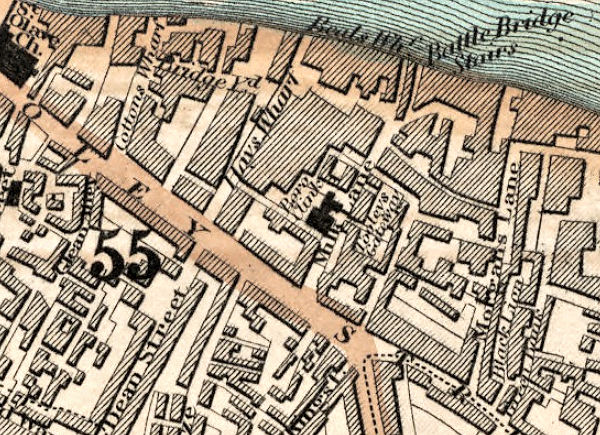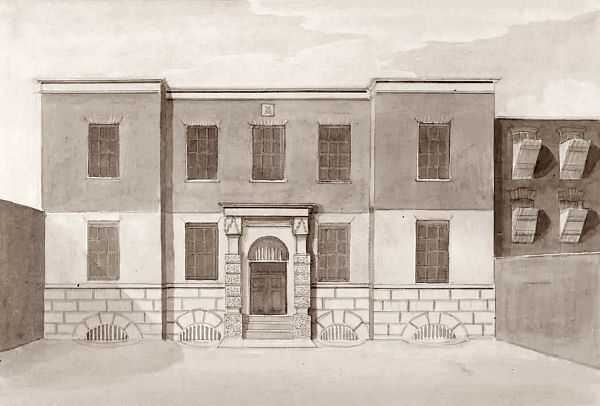Southwark Borough Compter, Southwark, London
The City of London was granted jurisdiction over the Borough of Southwark by royal charters from 1327. The City's Mayor, Recorder and Aldermen were appointed Justices of the Peace for Southwark and held court sessions there and needed their own prison. The former church of St Margaret, on Borough High Street, was used both as a courthouse and as a compter (or counter) until being destroyed in a fire in 1676. The compter was then rebuilt and enlarged. The Bridge Tap pub now occupies the site,
In 1717, a new compter was erected at the corner of Mill Lane (now Battle Bridge Lane) and Counter Lane, off Tooley Street, Southwark.
In 1777, John Howard wrote:
This prison, in Tooley-street, for the borough of Southwark, which contains four parishes and a part of a fifth, had in 1779, for master's-side debtors — seven rooms. — for common-side debtors, a room on the ground-floor, in which felons &c. were with them night and day; a long room up stairs, the Rookery; and a room over it, useless, because not secure.—The women were in the Stone kitchen, then divided into two rooms. Three of the common-side rooms had barrack-beds. Most of the debtors are poor creatures from the court of conscience, who lie there till their debts are paid.—There was a small court-yard; and a chapel, but no chaplain is appointed.
The whole prison was much out of repair, and ruinous. No infirmary. No bedding or straw. The keeper, on officer, pays Window-tax £2:15:0 and Land-tax £2:10:0. he is put in by the High Bailiff, whose office is in the disposal of the court of aldermen.—An inscription over the gate, dated 1716, calls it the Borough Court: but the courts are now held at St. Margaret's Hill.
The prison was burnt down in the Gordon Riots in 1780 and temporarily took up residence in a neighbouring house, hired by the keeper. In 1784, John Howard described the interim accommodation:
The court only 14½ feet by 11. A day-room below (17 feet by 12), stone-floor. The men's lodging-room (16 feet by 14) on the second floor, in which at my last visit there were 17, and sometimes there have been two or three and twenty. The women lodge in the common day-room. No bedding. Here are three or four rooms for those that pay. Debtors have 65 penny loaves once in eight weeks, from a legacy of Eleanor Gwinn. No memorial hung up, no table of fees, nor clauses against spirituous liquors. Debtors here, (as in the county gaol, King's Bench, the Fleet and Marshalsea) have a gift every Christmas of 20s. from the Archbishop of Canterbury.
The prison was rebuilt on its previous site in 1795. Its location (marked "Boro' Clink") is shown on the 1827 map below.

Southwark Borough Compter site, Southwark, c.1827.

Southwark Borough Compter, Southwark, London, c.1826. © Peter Higginbotham
In 1812, James Neild wrote:
The Borough Compter, vulgarly called. "The Clink," is under the Jurisdiction of the Bailiff of Southwark, controllable, however, by the City of London; and extends its influence over five Parishes. But, in August, 1806, the powers of the Court were still farther extended to Norwood, about seven miles distant; the number of commitments thereby increased in more than a triple degree. For the six years preceding, the annual average had been 152; but no sooner was the Jurisdiction enlarged, than the number of the committed in the first year increased to 549. The following is an exact List of Commitments hither, from 1801 to 1806, inclusive: In 1801,—180. In 1802,—160. In 1803,—170. In 1804,—125. In 1805,—131. And in 1806,—147.
Debtors have here one small court-yard, about 19 feet square. On the ground floor, on the right-hand, is the Women's day and sleeping-room, of 24 feet by 9 feet 6 inches. On the left hand is another, intended for Men, 41 feet by 10 : But the floor of this room being only of earth, or mud, and unfit to sleep on, no use has been made of it for many years; so that the Men and Women associate promiscuously together in the Women's apartments, during the day-time.
Above stairs are two rooms, of the same size as the former, and in pretty good repair. All these rooms have fire-places; but no coals are allowed; no kettles or saucepans to cook provisions; no mops, brooms or pails to keep the Gaol clean; no bedsteads, bedding, nor even straw to lie upon! Hence, the Debtors are obliged every night to sleep in their clothes upon the boards, than which the very streets can hardly be more filthily dirty.
All who are arrested by process issuing out of the Borough Court, are sent to this miserable Prison; and in the house there are rooms, of about 8 feet square, for such as can pay sixpence per night for a bed.
. In 1840 the City decided to use the Southwark Compter for female prisoners and female inmates were transferred there from the Giltspur Street Compter.
The Southwark Compter closed in 1852 and was demolished in 1855.
Records
Note: many repositories impose a closure period of up to 100 years for records identifying individuals. Before travelling a long distance, always check that the records you want to consult will be available.
- London Metropolitan Archives, 40 Northampton Road, London EC1R OHB. Holdings include: Lists of prisoners committed for trial at the Southwark Sessions (1814-42); Other lists of prisoners (1814-42); Charge books, with index (1814-42); Committals for debt (1811-30); Weekly return of the names of prisoners (1815-18); Inquests into deaths of prisoners (1783-1838); Return of duties, names and ages of officers (1846); Visiting records (1814-36); Journal of the Borough Compter (1817-23); Keeper's letter book 1817-1820 — CLA/031/02/020 Returns as to state of prison and prisoners' health (1815); Account books (1814-39); Plans (1686-1848).
- The National Archives, Kew, Richmond, Surrey, TW9 4DU. Has a wide variety of crime and prison records going back to the 1770s, including calendars of prisoners, prison registers and criminal registers.
- Find My Past has digitized many of the National Archives' prison records, including prisoner-of-war records, plus a variety of local records including Manchester, York and Plymouth. More information.
- Prison-related records on
Ancestry UK
include Prison Commission Records, 1770-1951
, and local records from London, Swansea, Gloucesterhire and West Yorkshire. More information.
- The Genealogist also has a number of National Archives' prison records. More information.
Bibliography
- Higginbotham, Peter The Prison Cookbook: A History of the English Prison and its Food (2010, The History Press)
- Brodie, A. Behind Bars - The Hidden Architecture of England's Prisons (2000, English Heritage)
- Brodie, A., Croom, J. & Davies, J.O. English Prisons: An Architectural History (2002, English Heritage)
- Harding, C., Hines, B., Ireland, R., Rawlings, P. Imprisonment in England and Wales (1985, Croom Helm)
- McConville, Sean A History of English Prison Administration: Volume I 1750-1877 (1981, Routledge & Kegan Paul)
- Morris, N. and Rothman, D.G. (eds.) The Oxfod History of the Prison (1997, OUP)
- Pugh R.B. Imprisonment in Medieval England (1968, CUP)
Links
- Prison Oracle - resources those involved in present-day UK prisons.
- GOV.UK - UK Government's information on sentencing, probation and support for families.
Except where indicated, this page () © Peter Higginbotham. Contents may not be reproduced without permission.



